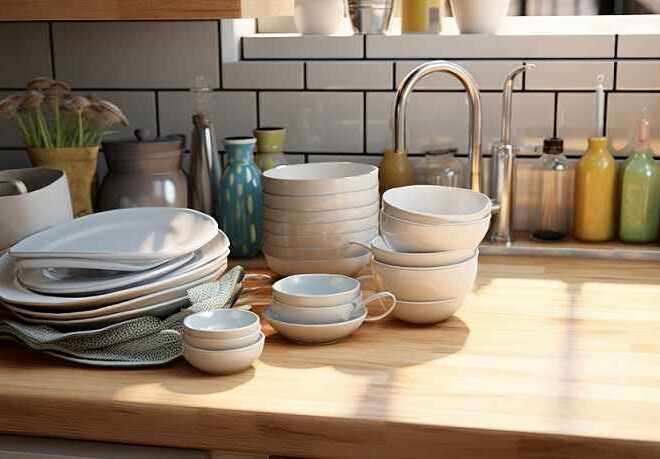
Step-by-Step Instructions for Crafting a Thriving Kitchen Herb Garden
Imagine stepping into your kitchen and plucking fresh basil, fragrant rosemary, or zesty cilantro right from your very own herb garden. Not only do these vibrant greens elevate your culinary creations, but they also bring a splash of nature’s beauty into your home. Whether you have a sprawling backyard or just a sunny windowsill, growing herbs is easier than you think! In this step-by-step guide, we’ll walk you through everything from selecting the right herbs for your space to nurturing them into lush greenery that will enhance every dish. Get ready to dig in and discover how simple it is to cultivate an aromatic oasis that’s bursting with flavor and health benefits – let’s get started on transforming your cooking experience!
Introduction to kitchen herb gardens
Imagine stepping into your kitchen, the air filled with the vibrant scents of fresh basil, rosemary, and mint. A kitchen herb garden can transform this dream into a delightful reality. Not only does it elevate your culinary creations, but it also adds a touch of greenery to your space.
Creating a thriving kitchen herb garden is easier than you might think. With just a few simple steps and some enthusiasm, you can grow an array of herbs right at home. Whether you’re an experienced gardener or a complete novice, cultivating these aromatic plants will enhance both your cooking and overall well-being.
Let’s dive into the essentials of kitchen herb garden creation and discover how to bring that fresh flavor from garden to table!
Benefits of having a kitchen herb garden
Creating a kitchen herb garden offers numerous advantages. Fresh herbs elevate the flavor of your meals, making them more vibrant and delicious. Imagine snipping basil or cilantro right before adding it to a dish—there’s nothing quite like that burst of freshness.
Additionally, growing your own herbs is cost-effective. Instead of purchasing small bunches at the store, you can cultivate an ongoing supply right at home. This not only saves money but also reduces waste.
Herb gardens promote sustainability too. By nurturing plants yourself, you’re minimizing your carbon footprint from transportation and packaging associated with store-bought herbs.
Moreover, tending to a garden can enhance mental well-being. The act of gardening provides stress relief and fosters mindfulness as you connect with nature in everyday life.
Lastly, having fresh herbs on hand encourages culinary creativity. You may find yourself experimenting with new recipes or flavors you might have otherwise overlooked.
Choosing the right location for your garden
Choosing the right location for your kitchen herb garden is crucial for success. Herbs thrive in areas that receive plenty of sunlight, ideally six to eight hours a day. Observe your space during different times of the day to locate those sun-soaked spots.
Next, consider accessibility. You want your herbs close enough to your kitchen so you can easily snip fresh leaves while cooking. A porch, balcony, or patio often works well for this purpose.
Additionally, think about drainage. Herbs dislike soggy roots; ensure water drains well from the containers or ground where you plant them.
Lastly, protect your garden from harsh winds and extreme weather conditions by placing it near walls or fences when possible. This careful attention to placement will set a strong foundation for your thriving herb garden.
Selecting herbs to grow in your garden
Selecting the right herbs is crucial to a successful kitchen herb garden. Start by considering what you enjoy cooking with most. Basil, parsley, and cilantro are popular choices that enhance many dishes.
Think about your climate and space as well. Some herbs thrive in full sun, while others prefer partial shade. Mint can spread rapidly; if you choose it, consider planting it in a pot to control its growth.
Herbs like rosemary and thyme require less watering and are perfect for those who may forget a watering schedule. If you’re looking for vibrant flavors, dill or tarragon can add excitement to your culinary creations.
Lastly, don’t shy away from experimenting with lesser-known herbs such as lemon balm or chives. They offer unique tastes that can elevate everyday meals into something special. Choose wisely and let your palate guide you!
Preparing the soil and containers for planting
Preparing the soil and containers for your kitchen herb garden is crucial for healthy growth. Start by selecting well-draining pots or containers. Terra cotta, ceramic, or plastic options work well. Ensure each pot has drainage holes to prevent waterlogging.
Next, focus on the soil. A high-quality potting mix specifically designed for herbs can make a significant difference. Look for one that contains organic matter like compost, as this enriches nutrients essential for plant development.
Before planting, loosen the soil in your container with a hand trowel or fork to encourage root expansion. You can also mix in some perlite or vermiculite for improved aeration and drainage.
Finally, dampen the soil slightly before planting your seeds or seedlings; it should be moist but not soggy. This simple preparation sets a solid foundation for thriving herbs in your kitchen garden.
Planting and caring for your herbs
Planting herbs is a simple yet rewarding task. Start by gently loosening the soil in your containers or garden bed to promote healthy root development. Space your plants adequately, allowing them room to breathe and grow.
Once planted, focus on watering. Herbs prefer consistent moisture but avoid waterlogging. A good rule of thumb is to check the top inch of soil; if it feels dry, it’s time for a drink.
Fertilizing can be beneficial too. Use an organic fertilizer every few weeks during the growing season. This gives your herbs the nutrients they need without overwhelming them.
Watch for signs of stress or disease in your plants. Yellow leaves may indicate overwatering, while wilting could suggest drought stress. Stay attentive and adjust care accordingly for thriving greenery right at home.
-
Watering and fertilizing tips
Watering your herbs correctly is crucial for their growth. Always check the soil moisture before watering. If the top inch feels dry, it’s time to hydrate.
When you water, do so thoroughly. Ensure that water seeps through the drainage holes at the bottom of your pots or garden bed. This encourages deep root growth and keeps plants healthy.
Fertilizing is just as important but should be approached with care. Use a balanced organic fertilizer every four to six weeks during the growing season. Herbs don’t thrive on excessive nutrients; less is often more in this case.
For an extra boost, consider compost tea or homemade fertilizers like diluted fish emulsion. These options provide nutrients without overwhelming delicate herb plants.
Remember, overwatering can lead to root rot while under-watering may stunt development—finding that sweet spot will nurture vibrant flavors in your culinary creations!
-
Pest control methods
Pests can be a gardener’s nightmare, but there are natural ways to keep them at bay. Start by encouraging beneficial insects like ladybugs and lacewings. They feast on common pests such as aphids.
Companion planting is another effective strategy. Herbs like basil can repel flies and mosquitoes, while marigolds deter nematodes in the soil.
If you spot an infestation, use neem oil or insecticidal soap sprayed directly onto affected plants. These options target pests without harming your herbs or the environment.
Regularly inspecting your plants helps catch issues early. Look under leaves for hidden invaders and check for any discolored foliage that might signal trouble.
Also, maintain good air circulation around your herbs by spacing them appropriately. This simple step reduces humidity levels that favor pest growth.
-
Harvesting techniques
Harvesting your herbs is an exciting part of the kitchen herb garden creation. Timing matters; it’s best to pick herbs in the morning when their essential oils are at peak levels.
Use clean, sharp scissors or pruning shears for a precise cut. This prevents damage and helps the plant heal quickly. For most herbs like basil, snip just above a leaf node to encourage bushy growth.
Don’t be afraid to take what you need! Regular harvesting stimulates new growth and keeps plants healthy. Aim for about one-third of the plant at a time, allowing it space to flourish.
Always wash your freshly harvested herbs gently under cool water. This removes dirt and any potential pests while preserving flavor integrity for cooking or home remedies. Enjoy experimenting with different flavors in your dishes!
Creative ways to use herbs in cooking and home remedies
Herbs can transform your culinary adventures. Fresh basil, for instance, elevates tomato sauces and salads with its aromatic charm.
Cilantro adds a burst of freshness to salsas and Asian dishes. Not a fan of cilantro? Try parsley instead—it brightens up any dish without overpowering it.
You can also infuse herbs into oils or vinegars for a unique dressing. Rosemary-infused olive oil drizzled over roasted vegetables is simply divine.
Don’t forget about herbal teas! Steep mint or chamomile leaves in hot water for soothing beverages that calm the mind.
Beyond cooking, herbs offer healing properties as well. Lavender can be used in homemade sleep sachets, while peppermint serves as a natural remedy for headaches when brewed as tea.
Experimenting with various combinations opens endless possibilities—both in flavor and wellness benefits.
Troubleshooting common issues with herb gardens
Herb gardens can face a few challenges, but many issues are fixable with some know-how.
One common problem is yellowing leaves. This often indicates overwatering or poor drainage. Ensure your pots have holes and adjust your watering schedule accordingly.
Pests like aphids might invade your garden, damaging delicate leaves. A simple solution is to spray a mixture of water and dish soap on the affected areas. This helps keep pests at bay without harsh chemicals.
If herbs are growing slowly, they may be lacking nutrients or light. Consider using organic fertilizers and relocating them to sunnier spots for optimal growth.
Lastly, if you notice wilting despite adequate care, check the soil moisture level. Sometimes it’s too dry or too wet; finding that balance is key for healthy herb plants!
Long-term maintenance of your herb garden
Long-term maintenance of your kitchen herb garden is essential for continued growth and productivity. Regularly check your plants for signs of distress, such as yellowing leaves or wilting stems. These might be indicators that adjustments are needed in watering or sunlight.
Pruning is another key aspect. Trim back overgrown herbs to encourage bushier growth and prevent them from becoming leggy. This also helps improve air circulation around the plants, reducing the risk of disease.
Rotate your herbs seasonally to keep soil nutrients balanced. Consider companion planting with different herbs; some thrive better when grown alongside certain varieties.
Don’t forget about enriching the soil periodically! Adding compost or organic fertilizers can provide an extra boost, ensuring robust flavor profiles in your culinary creations. By staying attentive and proactive, you’ll enjoy a flourishing herb garden year-round.
Conclusion: Enjoy the fruits (or herbs) of your labor!
Creating a thriving kitchen herb garden is a journey filled with excitement and reward. You’ve learned how to select the right location, pick your favorite herbs, and care for them properly. Each step along the way builds towards the satisfaction of seeing your plants flourish.
As you incorporate fresh herbs into your cooking or home remedies, you’ll discover new flavors and health benefits that elevate everyday meals. Imagine snipping off some basil for a homemade pesto or adding freshly chopped cilantro to your salsa—it’s an experience unlike any other.
The little challenges that may arise are part of the learning process. Whether it’s dealing with pests or understanding when to harvest, every hurdle teaches you something valuable about gardening.
Long-term maintenance ensures that your kitchen herb garden continues to thrive year after year. With proper attention, it can become an integral part of your culinary adventures.
Ultimately, there’s nothing quite like enjoying what you’ve grown yourself. So go ahead—embrace this rewarding hobby and savor both the taste and aroma of all those delightful herbs!


